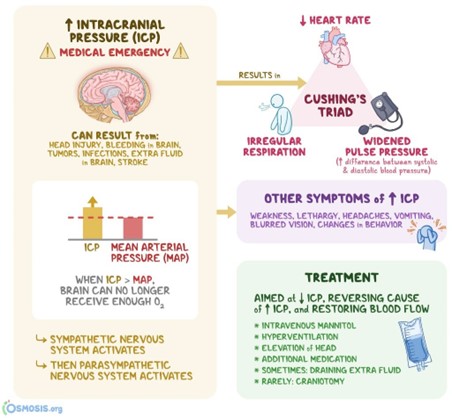A nurse is assisting in the planning of preventative care for a client who is restless following a traumatic brain injury with increased intracranial pressure. Which of the following is an appropriate nursing action?
Administer opioids.
Apply restraints.
Reduce stimuli.
Blacken the room.
The Correct Answer is C
An appropriate nursing action for a client who is restless following a traumatic brain injury with increased intracranial pressure is to reduce stimuli. This can help calm the client and prevent further increases in intracranial pressure. The nurse can reduce stimuli by minimizing noise and light in the client's environment and limiting the number of visitors.
Administering opioids, applying restraints, and blackening the room are not appropriate nursing actions for this situation. Administering opioids can cause respiratory depression and is not recommended for clients with increased intracranial pressure. Applying restraints can increase agitation and is not recommended for clients who are restless. Blackening the room can disorient the client and is not recommended.

Nursing Test Bank
Naxlex Comprehensive Predictor Exams
Related Questions
Correct Answer is B
Explanation
The knee is a hinge type of joint. When describing range-of-motion exercises, the nurse should explain that the knee is a hinge joint. A hinge joint is a type of synovial joint that mainly allows for flexion and extension (and a small degree of medial and lateral rotation)¹. The knee joint is formed by articulations between the patella, femur, and tibia.
a. The knee is not a pivot joint.
c. The knee is not a ball and socket joint.
d. The knee is not a gliding joint.
Correct Answer is D
Explanation
a. Auscultation of lungs revealing wheezing is not related to venous return in the affected arm. Wheezing is
a high-pitched whistling sound made while breathing and is usually a sign of a respiratory problem.
b.A bounding distal pulse indicates strong arterial blood flow, which is not a sign of impaired venous return. Impaired venous return would more likely result in a weak or absent pulse.
c. Fever could indicate infection but is not specific to impaired venous return. It's a systemic sign that may or may not be related to the cast or the fracture.
d. Pain that is unrelieved by opioid analgesics can be a sign of compartment syndrome, which is a serious complication that can result from impaired venous return and increased pressure within the muscle compartments. This requires immediate medical attention to prevent permanent damage.
Whether you are a student looking to ace your exams or a practicing nurse seeking to enhance your expertise , our nursing education contents will empower you with the confidence and competence to make a difference in the lives of patients and become a respected leader in the healthcare field.
Visit Naxlex, invest in your future and unlock endless possibilities with our unparalleled nursing education contents today
Report Wrong Answer on the Current Question
Do you disagree with the answer? If yes, what is your expected answer? Explain.
Kindly be descriptive with the issue you are facing.
